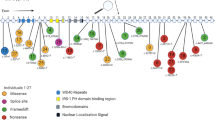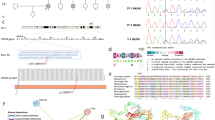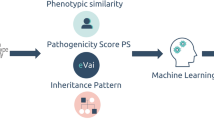Abstract
Hyperphosphatasia mental retardation (HPMR) syndrome is an autosomal recessive form of mental retardation with distinct facial features and elevated serum alkaline phosphatase. We performed whole-exome sequencing in three siblings of a nonconsanguineous union with HPMR and performed computational inference of regions identical by descent in all siblings to establish PIGV, encoding a member of the GPI-anchor biosynthesis pathway, as the gene mutated in HPMR. We identified homozygous or compound heterozygous mutations in PIGV in three additional families.

Similar content being viewed by others
Accession codes
References
Ng, S.B. et al. Nat. Genet. 42, 30–35 (2010).
Ng, S.B. et al. Nature 461, 272–276 (2009).
Roach, J.C. et al. Science 328, 636–639 (2010).
Mabry, C.C. et al. J. Pediatr. 77, 74–85 (1970).
Kruse, K., Hanefeld, F., Kohlschutter, A., Rosskamp, R. & Gross-Selbeck, G. J. Pediatr. 112, 436–439 (1988).
Horn, D., Schottmann, G. & Meinecke, P. Eur. J. Med. Genet. 53, 85–88 (2010).
McQuillan, R. et al. Am. J. Hum. Genet. 83, 359–372 (2008).
Rabe, P. et al. Am. J. Med. Genet. 41, 350–354 (1991).
Marcelis, C.L., Rieu, P., Beemer, F. & Brunner, H.G. Clin. Dysmorphol. 16, 73–76 (2007).
Thompson, M.D. et al. Am. J. Med. Genet. 152A, 1661–1669 (2010).
Kang, J.Y. et al. J. Biol. Chem. 280, 9489–9497 (2005).
Kinoshita, T., Fujita, M. & Maeda, Y. J. Biochem. 144, 287–294 (2008).
Nozaki, M. et al. Lab. Invest. 79, 293–299 (1999).
Takeda, J. et al. Cell 73, 703–711 (1993).
Almeida, A.M. et al. Nat. Med. 12, 846–851 (2006).
Acknowledgements
This work was supported by a grant from the Deutsche Forschungsgemeinschaft (SFB 665) to S.M., by a grant from Bundesministerium für Bildung und Forschung (BMBF, project number 0313911) and an Australian National Health and Medical Research Council international research training fellowship to T.R., and by a grant of the Canadian Institutes of Health Research and Epilepsy Canada to M.D.T. We thank B. Fischer, U. Kornak, M. Ralser, E. van Beusekom, U. Marchfelder and D. Lefeber for their assistance in this project.
Author information
Authors and Affiliations
Contributions
M.R.S., M.I. and A.D. performed targeted exome resequencing. P.M.K., C.R., A.F., M.K., S.B., S.K., M.J. and P.N.R. performed bioinformatic analysis. P.M.K., C. Marcelis, J.G., B.J.d.C., F.S. and T.R. performed mutation analysis and genotyping. D.H., C. Marcelis, M.D.T., D.E.C., S.D., P.M., E.P., T.R. and H.G.B. contributed to clinical evaluation of the affected individuals and delineation of the phenotype. P.M.K., U.K. and C. Meisel performed flow cytometric analysis. Y.M. and T.K. performed analysis of wild-type and A341E PIGV clones. P.M.K., M.R.S., D.H., J.H., H.G.B., P.N.R. and S.M. carried out the project planning and preparation of the manuscript.
Corresponding authors
Ethics declarations
Competing interests
The authors declare no competing financial interests.
Supplementary information
Supplementary Text and Figures
Supplementary Methods, Supplementary Note, Supplementary Figures 1–6 and Supplementary Tables 1–7 (PDF 1270 kb)
Rights and permissions
About this article
Cite this article
Krawitz, P., Schweiger, M., Rödelsperger, C. et al. Identity-by-descent filtering of exome sequence data identifies PIGV mutations in hyperphosphatasia mental retardation syndrome. Nat Genet 42, 827–829 (2010). https://doi.org/10.1038/ng.653
Received:
Accepted:
Published:
Issue Date:
DOI: https://doi.org/10.1038/ng.653
- Springer Nature America, Inc.
This article is cited by
-
A novel homozygous PIGO mutation associated with severe infantile epileptic encephalopathy, profound developmental delay and psychomotor retardation: structural and 3D modelling investigations and genotype–phenotype correlation
Metabolic Brain Disease (2023)
-
Establishment of mouse model of inherited PIGO deficiency and therapeutic potential of AAV-based gene therapy
Nature Communications (2022)
-
C18orf32 loss-of-function is associated with a neurodevelopmental disorder with hypotonia and contractures
Human Genetics (2022)
-
Target region sequencing and applications in plants
Journal of Crop Science and Biotechnology (2021)
-
The Glycosylphosphatidylinositol biosynthesis pathway in human diseases
Orphanet Journal of Rare Diseases (2020)





